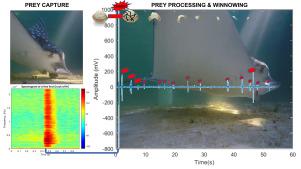Journal of Experimental Marine Biology and Ecology ( IF 1.8 ) Pub Date : 2020-12-17 , DOI: 10.1016/j.jembe.2020.151497 Matthew J. Ajemian , Catherine Lamboy , Ali Ibrahim , Breanna C. DeGroot , Kimbrough Bassos-Hull , David A. Mann , Laurent Chérubin

|
Durophagy (shell-crushing) is a predatory mode that has evolved across numerous marine taxa from relatively sessile crustaceans to large and highly mobile fishes and mammals. Despite its preponderance in the marine environment, the ecology of durophagy (i.e., dynamics and spatiotemporal distribution) remains poorly understood especially for highly mobile species, limiting our ability to quantify their predatory effects on benthic communities. Here, we used passive acoustics (i.e., remote monitoring of underwater sounds with acoustic recorders) to characterize consumption of hard-shelled mollusk prey by a model predator, the whitespotted eagle ray (Aetobatus narinari). Acoustic recordings were made in captivity for 434 total prey items, spanning eight species of hard-shelled mollusks (1 bivalve, 7 gastropods). For all prey types, consumption sequences were generally characterized by an initial high-energy signal (Sound Pressure Level > 160 dB re 1μPa), presumably associated with shell failure, followed by numerous additional signals of lesser energy as prey was further fractured and winnowed by the predator. Fracture events were short-lived (<0.1 s) with peak frequencies ranging from 3.1 to 5.0 kHz, depending on prey type. Statistical analyses showed capacity to distinguish between the two dominant prey types offered (hard clam, Mercenaria mercenaria and banded tulip, Cinctura lilium) based on processing time, the number of fractures, as well as using a suite of energy and spectral features associated with these acoustic signals. Importantly, we noted that the directionality of these relationships (i.e., relative differences in signals between prey types) can change depending on the chronological location within a consumption sequence and the amount of data analyzed (e.g., first fracture event vs. all fracture event), which may present analytical challenges. Additionally, in situ simulation of fracture events in the target environment suggested events could be detected above ambient noise out to 100 s of m. To our knowledge, this is the first attempt to both quantify and classify durophagy using passive acoustics. We recommend that future studies conduct extensive testing in controlled and target environments to build robust data sets capable of supporting feature extraction as well as detection-classification schemes via machine-learning. Lastly, collaborations with biomechanical scientists are suggested to facilitate a better understanding of the mechanisms driving acoustic variation of shell fracture across prey taxa.
中文翻译:

使用无源声学技术捕获大型移动捕食者的碎壳
Durophagy(贝壳粉碎)是一种掠食性模式,已从无数甲壳类动物转变为大型且高度活动的鱼类和哺乳动物,在众多海洋生物群中得到了发展。尽管其在海洋环境中占优势,但对吞噬作用的生态学(即动力学和时空分布)仍然知之甚少,特别是对于高度活动的物种,这限制了我们量化其对底栖生物的掠食性影响的能力。在这里,我们使用无源声学(即用声学记录仪远程监控水下声音)来描述模型捕食者白斑鹰射线(Aetobatus narinari)对硬壳软体动物猎物的消费特征。)。圈养了434种猎物的声学记录,涵盖了8种硬壳软体动物(1个双壳类,7个腹足类)。对于所有类型的猎物,消耗序列通常以初始的高能量信号(声压级> 160 dB re1μPa)为特征,大概与外壳故障有关,随后随着猎物被进一步破碎并被风吹扫,许多能量较低的附加信号捕食者。骨折事件是短暂的(<0.1 s),峰值频率范围为3.1到5.0 kHz,具体取决于猎物的类型。统计分析显示能力(提供了两个主要的猎物类型之间进行区分硬壳蛤,硬壳蛤和带状郁金香,Cinctura百合),取决于处理时间,裂缝数量,以及使用与这些声信号相关的一组能量和频谱特征。重要的是,我们注意到这些关系的方向性(即猎物类型之间信号的相对差异)可能会根据消耗序列中的时间顺序和所分析的数据量(例如,第一次断裂事件与所有断裂事件)而变化。 ,这可能会带来分析上的挑战。此外,就地在目标环境中模拟裂缝事件,建议的事件可以在高于环境噪声达100 s m的时间内检测到。据我们所知,这是使用被动声学对双相吞噬进行量化和分类的首次尝试。我们建议未来的研究在受控和目标环境中进行广泛的测试,以构建能够支持特征提取以及通过机器学习进行检测分类的强大数据集。最后,建议与生物力学科学家合作以促进对驱动整个猎物分类中壳破裂声变化的机理的更好理解。











































 京公网安备 11010802027423号
京公网安备 11010802027423号